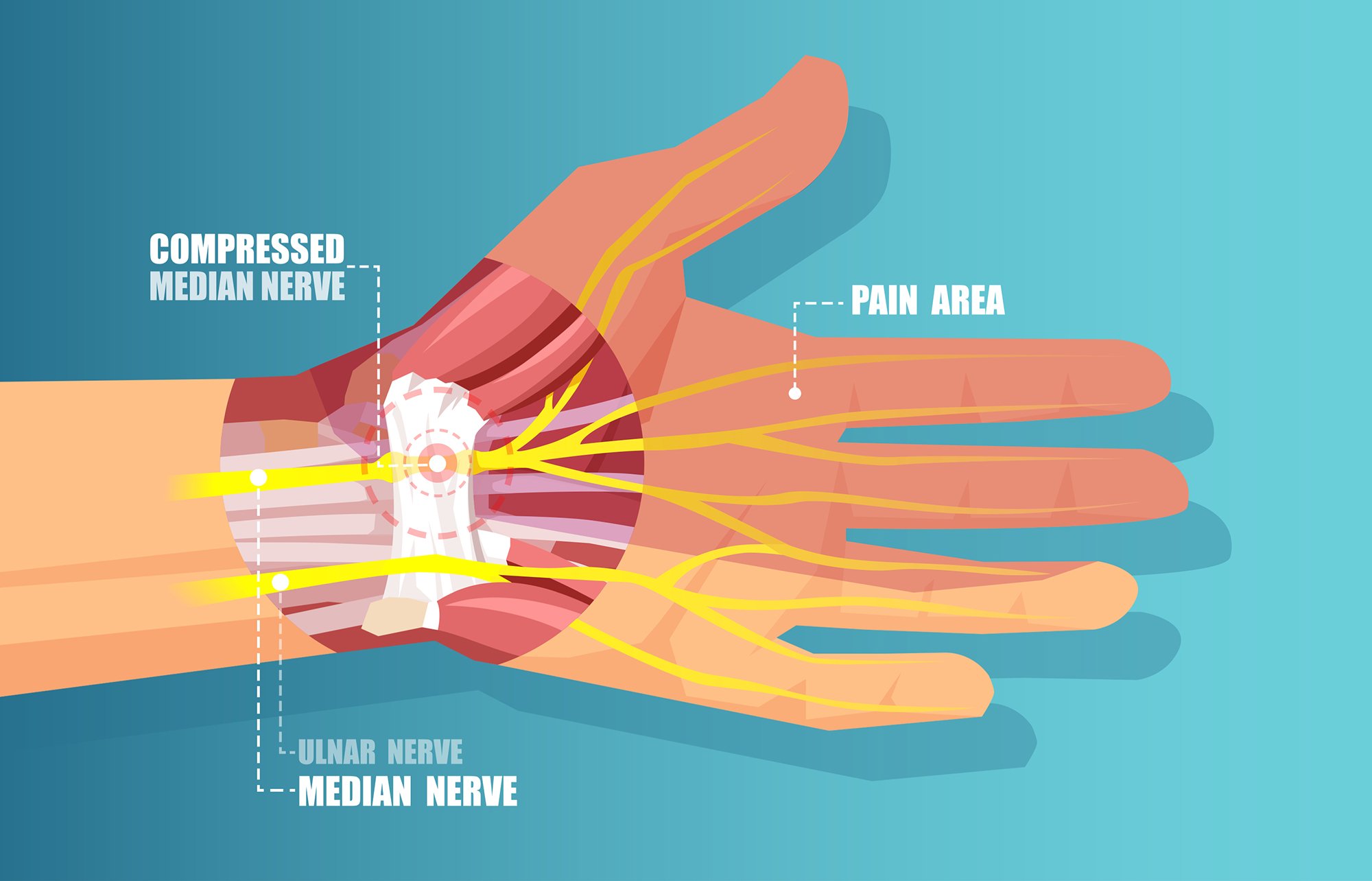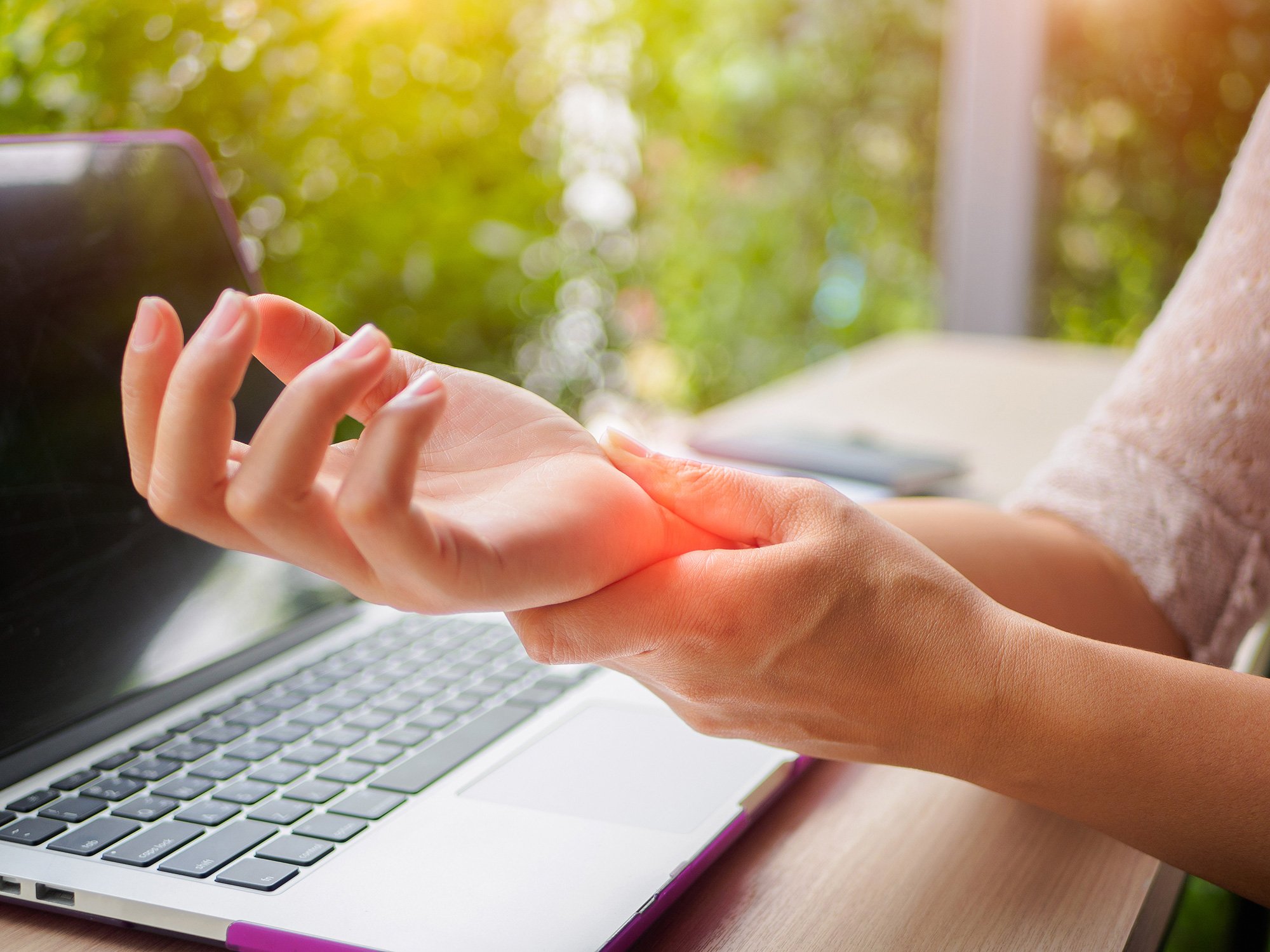What is Carpal Tunnel Syndrome?
Carpal tunnel syndrome is the most common condition we treat at Orthopedics Hawaii. It’s a condition that causes pain, weakness, tingling and numbness in your wrist, hand and fingers. Carpal tunnel syndrome is caused when there is increased pressure on the median nerve, which runs within the wrist. This nerve provides feeling to the thumb, index, and middle fingers, and to half of the ring finger. The small finger (pinky) is usually not affected.
What is the Carpal Tunnel?
Similar to a tunnel that a car drives through, the carpal tunnel is a narrow canal that guides the median nerve and tendons to the fingertips. The parts of this tunnel include:
Carpal bones: Shaped like a semi-circle, these bones form the bottom and sides of the tunnel.
Ligament: The top of the tunnel is the ligament, which is a strong tissue that holds the tunnel together.
The median nerve and tendons run through the tunnel.
Median nerve: This nerve provides sensation to all of the fingers in the hand, except the pinky. It also provides nerve signals to move the muscles around the base of the thumb (motor function).
Tendons: The tendons connect muscles in the forearm to the bones in the hand. They are rope-like structures that allow the fingers and thumb to bend.
Causes
Carpal tunnel syndrome is caused by pressure or irritation to the median nerve. The carpal tunnel can narrow due to a wrist fracture which will irritate the nerve. Rheumatoid arthritis may also cause swelling and inflammation of the median nerve contributing to the development of carpal tunnel syndrome. In many cases, there is no identifiable single cause of the condition. It is often a combination of risk factors that contributes to the development over time.
It’s a misconception that only factory or office workers develop carpal tunnel syndrome. Anyone can develop the condition but jobs with repetitive hand motions have an increased risk. Developing carpal tunnel syndrome also increases with age. Read more risk factors below
Symptoms
Symptoms usually start gradually and may include:
Tingling or numbness in the fingers or hand. Typically the thumb and fingers (except for the pinky finger) are affected. You may also experience a sensation like an electric shock through these fingers. That feeling may travel from the wrist up the arm. These symptoms often occur while holding a steering wheel or phone, and you may experience these sensations while you are sleeping. Many people "shake out" their hands to try to relieve their symptoms. The numb feeling may become constant over time.
Another common symptom is Weakness in the hand which may cause you to drop objects. This may result from numbness in the hand or weakness of the thumb's pinching muscles which are controlled by the median nerve.
Risk Factors
The following risk factors are associated with carpal tunnel syndrome. Although they may not directly cause the condition, they can increase the risk of irritation or damage to the median nerve.
Activity and Occupation
Activities or jobs that require repetitive motion and finger use can lead to carpal tunnel syndrome. Especially activities that involve high-force movement (hammering), long-term finger use, extreme wrist motions and vibration.
Mouse & Keyboard Use - Some studies suggest it is mouse use, not the use of a keyboard, that may increase your risk of developing the condition.
Anatomic Factors
Suffering a fractured or dislocated wrist, or arthritis that deforms the small bones in the wrist, can narrow the space within the carpal tunnel and put pressure on the median nerve.
Hereditary - smaller carpal tunnels can run in families. Individuals with smaller carpal tunnels may be more likely to develop carpal tunnel syndrome.
Sex
The condition is more common in women. This may be because the carpal tunnel area is relatively smaller in women compared to men.
Women who have carpal tunnel syndrome may also have smaller carpal tunnels than women who don't develop the condition.
Nerve-damaging Conditions
Chronic conditions like diabetes may increase the risk of nerve damage, including damage to the median nerve.
Inflammatory Conditions
Arthritic diseases like rheumatoid arthritis and gout can affect the lining around the tendons in the wrist and put pressure on the median nerve.
Medications
Some studies have shown a link between carpal tunnel syndrome and the use of anastrozole (Arimidex), a drug used to treat breast cancer.
Body Fluid Changes
It’s common during pregnancy and menopause to experience increased fluid retention which can increase the pressure within the carpal tunnel, irritating the median nerve. Carpal tunnel syndrome brought on by pregnancy usually resolves on its own after pregnancy.
Other Medical Conditions
The following conditions may increase your risk: menopause, thyroid disorders, kidney failure and lymphedema.
Obesity
Prevention
While there is no way to prevent carpal tunnel syndrome, there are ways to lower your risk by minimizing the strain on your hands and risks. The following are suggestions that may reduce your risk:
Relax Your Grip and Lower Your Force
Many of our jobs require long hours on a computer. Instead of hitting the keys with force, type softly. If you do a lot of writing, utilize a larger pen or pencil with an oversized grip which will help you relax your grip and in turn the muscles in your hand and forearm.
Short Frequent Breaks
Take regular short breaks in between hand and wrist-intensive activities. During these breaks you may gently stretch and bend your hands and wrists. We also recommend alternating tasks so you aren’t spending hours making repetitive motions. This is especially important if you use equipment that vibrates or that requires you to exert a great amount of force.
Maintain Proper Form
When using a keyboard keep it at elbow height or slightly slower. Keeping your hands and wrists in a relaxed middle position is recommended. Try to avoid bending your wrist all the way up or down.
Improve Your Posture
Seemingly little things like your posture can impact even your hands and wrists. If you have your shoulders rolled forward it shortens your neck and shoulder muscles which can compress the nerves in your neck. In addition to neck pain, this incorrect posture can affect the wrists, fingers and hands.
Computer Mouse
Make sure your computer mouse is comfortable and doesn't strain your wrist. There are many ergonomically designed options available.
Keep Your Hands Warm
If you work in a cold environment you are more prone to developing pain and stiffness in your hands. If you aren’t able to control the temperature of your workspace, we recommend wearing gloves or fingerless gloves that keep the hands and wrists warm.
How Can Orthopedics Hawaii Help?
If you are experiencing hand, wrist or finger pain come in to see us. All of our patients are seen by Hand Specialist and Orthopedic Surgeon Dr. Sam Chen. We recommend scheduling an appointment by calling (808) 744-3360 or emailing aloha@orthopedicshi.com.



